EtherCAT Slave Device
EtherCAT Slave Device "EtherCAT" tab:
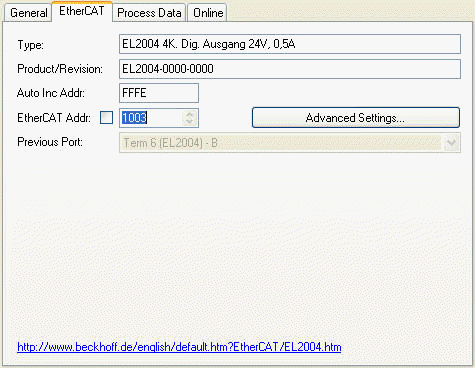
Type: Name of the EtherCAT Slave device.
Product/Revision: Product and Revision number of the EtherCAT slave device.
Auto Inc Addr: The Auto Increment Address of the EtherCAT slave device. Auto-increment addressing can be used to address each slave device via its physical position in the communication ring. Auto-increment addressing is used during the start-up phase, during which the master assigns the EtherCAT Address to the slaves. The first slave in the ring has an address of 0 and for each following the addresses is decremented (0xFFFF(-1),0xFFFE(-2) etc.).
EtherCAT Addr: The fixed Address of the EtherCAT slave device. This address is set by the master during the start-up phase. To change the default value, you must check the box left to the address.
Advanced Settings: Opens the Advanced Settings dialog.
Previous Port: The port and name of the EtherCAT slave device this device is connected to. If it is possible to connect this device to a different without changing the order of the EtherCAT slave devices in the communication ring, the combo box is enabled, and one can select the EtherCAT device this device should be connected to.
EtherCAT Slave Device "Process Data" tab:
Displays the configuration of the process data. The input and output variables of the slave device are displayed as CANopen Process Data Objects (PDO). If supported by the slave device this dialog enables the user to select a different PDO via PDO Assignment and to alter to contents of an individual PDO.
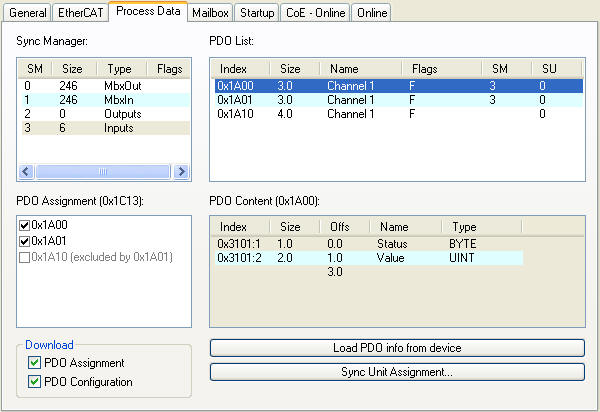
Sync Manager: Lists the configuration of the sync managers. If the device has a mailbox the sync manager 0 is used for the mailbox output and the sync manager 1 is used for the mailbox input. The next Sync Manager is used for the process data outputs and the last sync manager for the process data inputs. If an item is selected the corresponding PDO Assignment is displayed in the list view "PDO Assignment(0x1C1Sm)" (where Sm is the number of the sync manager).
PDO Assignment (0x1C1Sm) (where Sm is the number of the sync manager): PDO Assignment for the selected Sync Manager. Here all PDOs defined for this Sync Manager type are listed with their index. If the Outputs Sync Manager is selected in the "Sync Manager" list view, all TxPDOs are displayed. If the Inputs Sync Manager is selected, all RxPDOs are selected. The checked items are the PDOs, that take part in the process data communication. These PDOs are displayed in the tree view of the System Manager as variables of this EtherCAT slave device. The name of the variable is identical to the Parameter "Name" of the PDO, as displayed in the list view "PDO List". If an item in the "PDO Assignment" list is disabled (unchecked and gray), it indicates that this item is excluded for the current PDO assignment. To be able to select this PDO, one has to uncheck the currently checked PDOs.
PDO List: Lists all PDOs supported by this EtherCAT slave device. The content of the selected PDO is displayed in the "PDO Content (index of PDO):" list view. By double clicking on an entry one can change the configuration of the PDO.
Column | Description: | |
|---|---|---|
Index | Index of the PDO. | |
Size | Size of the PDO in bytes. | |
Name | Name of the PDO. If this PDO is assigned to a sync manager, it appears as variable of the slave device with this Parameter as name. | |
Flags | F | Fixed Content. The content of the PDO is fixed and cannot be changed by the System Manager. |
M | Mandatory PDO. This PDO is mandatory and therefore must be assigned to a Sync Manager. Therefore, one cannot uncheck this item in the "PDO Assignment" list. | |
SM | The Sync Manager this PDO is assigned to. If this entry is empty the PDO does not take part in the process data communication. | |
SU | Sync Unit this PDO is assigned to. | |
PDO Content (Index of PDO ): Displays the contents of a PDO. If the Fixed Content Flag(Flag = F) of the PDO is not set, the content can be changed by the user.
Download: If the device is an intelligent device and has a mailbox, the configuration of the PDOs and the PDO assignments can be downloaded to the device. This is an optional feature and is not supported by all slave devices.
PDO Assignment: If this box is checked, the PDO Assignment configured in the "PDO Assignment" list view is downloaded to the slave device during startup. The necessary commands sent to the device can be viewed in the "Startup" tab.
PDO Configuration: If this box is checked, the configuration of the individual PDOs as displayed in the "PDO List" and PDO Content" view are downloaded to the EtherCAT slave device.
EtherCAT Slave Device "Online" tab:
Displays online information about the EtherCAT slave device.
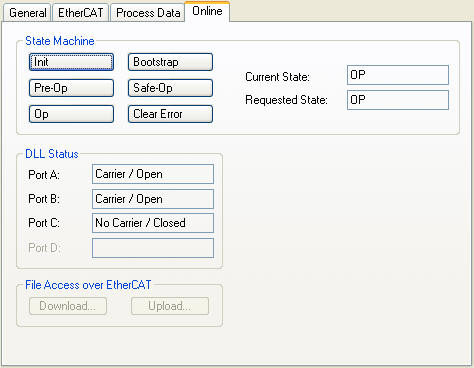
State Machine:
Init: Tries to set the EtherCAT slave device to the Init State.
Pre-Op: Tries to set the EtherCAT slave device to the Pre-Operational State.
Safe-Op: Tries to set the EtherCAT slave device to the Safe-Operational State.
Op: Tries to set the EtherCAT slave device to the Operational State.
Bootstrap: Tries to set the EtherCAT slave device to the Bootstrap State.
Clear Error: Tries to clear the error flag. If a slave device fails to change to another state, it sets the error flag. For instance, a slave device is currently in the Pre-Operational state. Then the master requests the Safe-Operational state. If the slave device fails to change to Safe-Operational, it sets the error flag. The current state would be displayed as "ERR PREOP". After pressing the Clear Error, the error flag is cleared and the current state would be displayed as "PREOP" again.
Current State: Current EtherCAT State of the slave device.
Requested State: EtherCAT State the master tried to set the slave to.
Dll Status:
The Data Link Layer (DLL) Status contains status information concerning the individual ports(A, B and C) of a slave device. Four different values for the DLL status are possible:
Status | Description |
|---|---|
Carrier / Open | No carrier signal is present on the port, but the port is open. |
Carrier / Closed | No carrier signal is present on the port and the port is closed |
Carrier / Open | Carrier signal is present on the port and the port is open. |
Carrier / Closed | Carrier signal is present on the port, but the port is closed. |
EtherCAT Slave Device "Mailbox" tab:
If the EtherCAT slave devices supports one or more mailbox protocols the additional tab "mailbox" appears. In this dialog the supported mailbox protocols are listed, and the configuration of the mailbox can be changed.
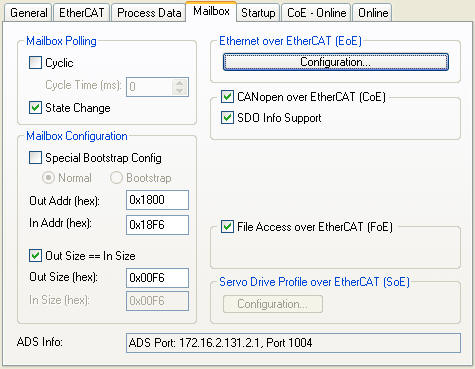
Mailbox Polling:
Cyclic: If this box is checked, the master cyclically tries to read out the mailbox .
Cycle Time(ms): If the "Cyclic" box is checked, this value determines how often the master reads out the mailbox of the slave.
State Change: If this box is checked, the master checks a status bit of the slave, to determine if unread data is available in the mailbox. Only then does the master read out the total mailbox. This mode is more efficient than the "Cyclic" mode, because the master can read out the status of several slave mailboxes with one EtherCAT command(LRD).
CANOpen over EtherCAT(CoE): If this box is checked, the slave supports the CANOpen over EtherCAT(CoE) mailbox protocol.
SDO Info Support: If this box is checks, the object dictionary of the slave device can be loaded by the master.
File Access over EtherCAT(FoE): If this box is checked, the master supports the File Access over EtherCAT(Foe) mailbox protocol.
Servo Drive over EtherCAT(SoE): If this group is enabled, the slave supports the Servo Drive over EtherCAT mailbox protocol.
Configuration..: Opens a dialog for configuring the Servo Drive over EtherCAT mailbox protocol.
ADS Info: The ADS identification of the EtherCAT slave device. The ADS Net id is the same as the NetId of the EtherCAT device, the ADS Port is the same as the fixed address of the EtherCAT device (see EtherCAT Addr). With the help of ADS one can communicate with the the mailbox of the slave device (e.g. SDO Upload Request).
EtherCAT Slave Device "CoE-Online" tab:
If the EtherCAT slave device supports the CANopen over EtherCAT(CoE) protocol, the additional tab "CoE-Online" appears. This tab enables the user to view the contents of the object dictionary of the slave (SDO-Upload) and to change the contents of an object in the dictionary(SDO-Upload).
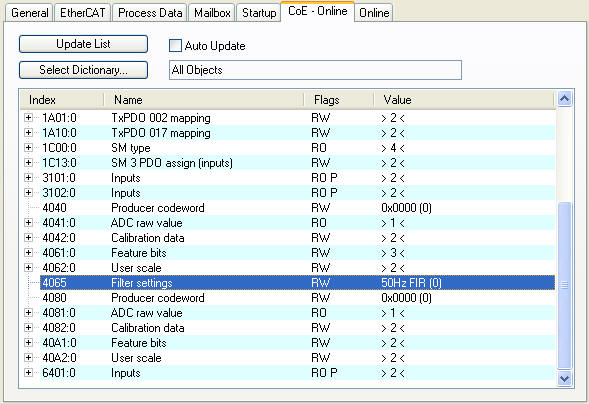
Object List View:
Column | Description | |
|---|---|---|
Index | Index and Subindex of the object. | |
Name | Name of the object. | |
Flags | RW | The object can be read out and data can be written to the object. |
RO | The object can be read out but is not possible to write data to the object. | |
P |
| |
Value | Value of the object. | |
Update List: Updates all objects displayed in the list view.
Auto Update: If this box is checked, the contents of the objects is updated automatically.
Select Dictionary...: Opens the Select Dictionary dialog. Here one can specify which objects are displayed in the list view.
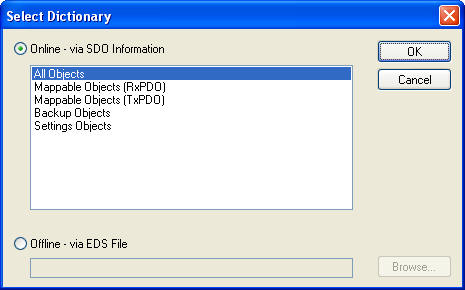
Online - via SDO information: If this box is selected, the list of objects contained in the object dictionary of the slave is uploaded from the slave via SDO information. In the list view below one can specify which type of objects should be uploaded.
Offline - via EDS File: If this box is selected, the list of objects contained in the object dictionary is read from an EDS File supplied by the user.
EtherCAT Slave Device "Startup" tab:
The "Startup" tab is displayed if the slave device has a mailbox and supports either the CANopen over EtherCAT(Coe) protocol or the Servo Drive over EtherCAT(SoE) protocol. With the help of the "Startup" tab the user can view which download requests are sent to the mailbox during startup. It is also possible to add new mailbox requests to the list view. The download requests are sent to the slave in the same order as displayed in the list view.
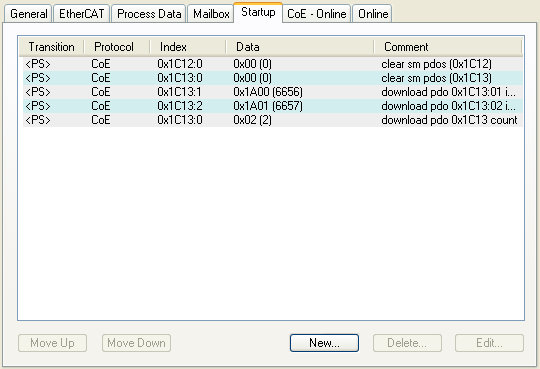
Column | Description |
|---|---|
Transition | Transition the request is sent in. This can be either Pre-Operational to Safe-Operational (PS) or Safe-Operational to Operational (SO). If the transition is enclosed in "<>" (e.g. <PS>), the mailbox request is fixed and cannot be changed or deleted by the user. |
Protocol | Mailbox protocol. |
Index | Index of the object. |
Data | Data that is downloaded to the object. |
Comment | Description of the request sent to the mailbox. |
Move Up: Moves the selected request up one position in the list.
Move Down: Moves the selected request down one position in the list.
New..: Adds a new mailbox Download request, that should be sent during startup, to the list.
Delete..: Deletes the selected item
Edit...: Edits an existing request.